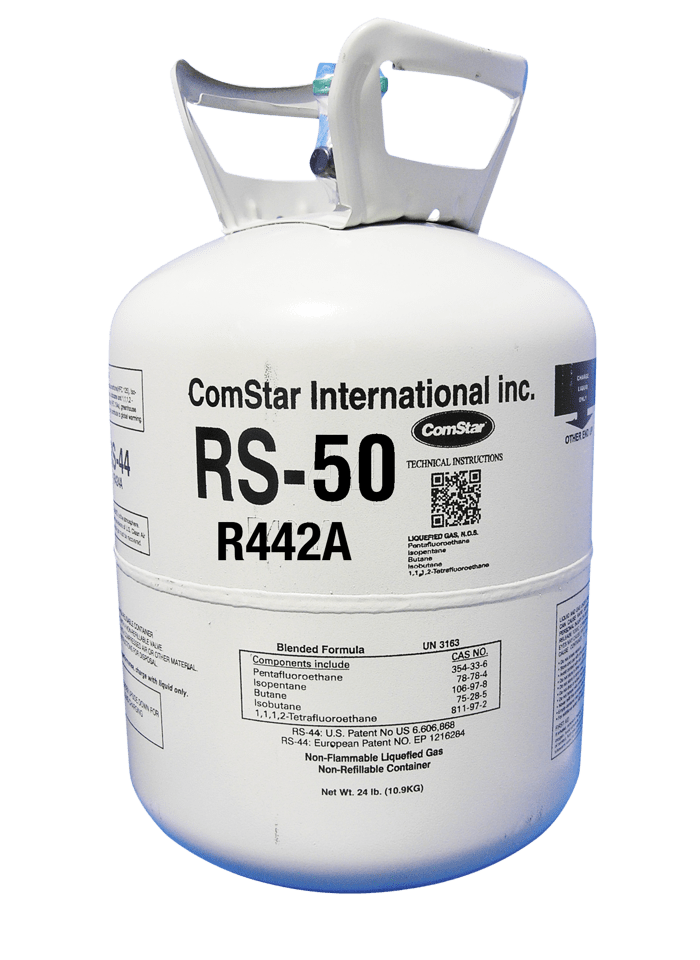This website uses cookies so that we can provide you with the best user experience possible. Cookie information is stored in your browser and performs functions such as recognising you when you return to our website and helping our team to understand which sections of the website you find most interesting and useful.
RS-50
Frequently Asked Questions
What is RS-50?
RS-50 is a non ozone depleting low GWP replacement for R404A and R507, and also for R22 in refrigeration.
Yes, but what does RS-50 contain?
RS-50 is a blend of R32a, R125, R134a, R227ea and R152a.
Is RS-50 subject to a phase out programme under any regulations as is the case with CFCs and HCFCs?
No. None of the components of RS-50 is subject to a phase out schedule under the Montreal Protocol or any regulations.
Can RS-50 be used with the same lubricant when replacing R404A and R507?
Yes. RS-50 is fully compatible with synthetic lubricants such as polyol ester (POE) which are commonly used with R404A and R507.
Can RS-50 be used with the same lubricant when replacing R22?
No. RS-50 is not compatible with mineral and alkylbenzene oils, lubricants commonly found in use with R22. A complete change of lubricant to POE is required when replacing R22 with RS-50.
Is RS-50 non flammable and non toxic?
RS-50 is both non flammable and non toxic. RS-50 is non flammable under all conditions of fractionation under ASTM 681-09.
Is RS-50 approved by compressor manufacturers?
The individual components which comprise RS-50 are widely used in compressors produced by major manufacturers.
How efficient is RS-50?
Tests show that RS-50 has a considerably higher Coefficient of Performance than R404A and R507 which provides a significant energy saving for users.
What trials have been carried out on RS-50 and what are the results?
Extensive independent testing has been carried out which clearly demonstrates that RS-50 has higher energy efficiency than R404A, R507, R407A and R407F at low temperature.
Does RS-50 need to be charged in the liquid or gaseous form?
Because RS-50 is a blend, the recommendation is to charge it into the system in the liquid form. However, if the entire contents of the cylinder are being charged, then vapour charging is acceptable.
Does the RS-50 disposable cylinder have a dip tube?
No. The disposable should be inverted to discharge RS-50 in the liquid form.
Is RS-50 on the SNAP (Significant New Alternative Policy programme) list in the USA?
Yes, RS-50 is approved for use by the US Environmental Protection Agency.
Does RS-50 have an ASHRAE number & what is its classification?
Yes. RS-50 has been designated an ASHRAE number of R442A with a classification of A1, which is low toxicity & non flammable under all conditions of fractionation.
How does the pressure rating of RS-50 compare with R22, R404Aand R507?
The discharge pressure of RS-50 is similar to R404A and R507, and higher than R22.
How does the capacity of RS-50 compare to R404A and R507?
The capacity of RS-50 is higher than R404A and R507, with a quicker pulldown time.
How does the temperature rating of RS-50 compare to R22, R404A and R507?
The discharge temperature of RS-50 is lower than R22 and higher than R404A and R507.
What are the flammability characteristics of RS-50?
RS-50 is non flammable at room temperature and atmospheric pressure, and has the same classification as R12, R134a, R404A, R409A (FX56), R507 (AZ-50) etc.
What are the decomposition products resulting from the combustion of RS-45?
The decomposition products resulting from subjecting RS-50 to a high temperature source are similar to those when R404A and R507 are exposed to fire conditions. The decomposition products in each case are irritating and toxic, and breathing apparatus should be worn where a possibility to exposure exists.
Are there any special precautions with RS-50?
There are no specific precautions which must be taken with RS-50. As with all refrigerants, common sense and good housekeeping is always recommended
Is RS-50 compatible with refrigeration and air conditioning systems designed for R404A, R507 and R22?
Yes. RS-50 is compatible with all materials commonly used in systems that were designed and charged with R404A, R507 and R22. Magnesium and zinc alloys should be avoided.
Can RS-50 be recovered and recycled?
Yes. RS-50 can be recovered and re-used after a cleaning process such as reclamation.
What technical guidance do you advise when changing from R404A or R507 to RS-50?
Use the same type of lubricant which will be polyolester, replace the filter/drier and charge 10% less quantity of RS-50 as the original charge for R404A or R507 after fully evacuating. RS-50 has a lower liquid flow rate than R404A and R507, so that it may be necessary to replace the expansion device with a valve approximately 40% smaller.
In systems operating with R404A or R507, what if any adjustments need to be made to electronic expansion valves when using RS-50 (R442A)?
Electronic expansive valves that operate on temperature difference only will have to be adjusted to allow for the evaporator glide. The estimated glide must be added to the recommended evaporator superheat setting for the equipment and the valve adjusted accordingly. Electronic expansive valves that operate on evaporator pressure converted to temperature will have to be re-programmed for the pressure temperature relationship of RS-50 (R442A).
What technical guidance do you advise when changing from R22 to RS-50?
If mineral oil or alkylbenzene are being used in the system, which is common in the case of R22, it is necessary to change the lubricant to a miscible lubricant such as a polyol ester. It is advisable to check with the compressor manufacturer which type and viscosity of lubricant to use. The remaining amount of mineral oil or alkylbenzene left in the system should be less than 5%. Charge 10% less quantity of RS-50 as the original charge for R22 after fully evacuating. Since the mass flow of R442A is similar to R22, it should not be necessary to replace the expansion device, but superheat should be checked and the TXV adjusted as necessary.
In systems operating with R22, what, if any, adjustments need to be made to electronic expansion valves when using RS-50 (R442A)?
Electronic expansive valves that operate on temperature difference only will have to be adjusted to allow for the evaporator glide. The estimated glide must be added to the recommended evaporator superheat setting for the equipment and the valve adjusted accordingly. Electronic expansive valves that operate on evaporator pressure converted to temperature will have to be re-programmed for the pressure temperature relationship of RS-50 (R442A). The capacity rating of a R22 valve will be similar when operating on RS-50 (R442A).
How does RS-50 compare in price with R404A and R507?
RS-50 is competitive in price with R404A and R507.
What is the main advantage of RS-50?
RS-50 has a considerably higher Coefficient of Performance than R404A and R507 at low temperature which can realise serious energy savings for users. In addition, RS-50 has a Global Warming Potential which is less than half that of R404A and R507 which results in a lower carbon footprint.
Is RS-50 compatible with hoses, seals, gaskets and O-rings commonly used with R404A and R507?
Yes, there is no necessity change any seals, hoses etc when replacing R404A and R507 with RS-50.
Is RS-50 compatible with hoses, seals, gaskets and O-rings commonly used with R22?
RS-50 (R442A) is compatible with materials commonly used in refrigeration systems previously charged with R22. In general, materials which are compatible with R22 can be used with RS-50 (R442A). It is recommended to check equipment manufacturer's retrofit literature and obtain recommendations from equipment manufacturers with regard to materials' compatibility. In older systems which have been operating on R22 for many years, replacement of some seals may be required due to the different composition of RS-50 (R442A) which contains HFCs.
How does the Coefficient of Performance (COP) of RS-50 compare with R404A and R507?
Independent tests show that RS-50 provides a considerably higher COP than R404A and R507 at l,ow temperature.
What is the specification for RS-50?
RS-50 complies with the refrigerant specification AHI 700 for fluorocarbon refrigerants.
What is the effect of high exposure by inhalation of RS-50?
As is the case with all CFC, HCFC and HFC based refrigerants, high exposure to RS-50 may produce anaesthetic effects. Very high exposures may cause an abnormal heart rhythm and prove suddenly fatal as is the case with all CFC, HCFC and HFC based refrigerants.
What is the flash point, flammability explosion limits and auto-ignition temperature for RS-50?
RS-50 is non flammable as defined in the ASHRAE EN 681-09 test, and hence does not have a flash point or explosion limits. The auto-ignition temperature of RS-50 has not been determined but is expected to be greater than 750oC.
What types of leak detectors should be used with RS-50?
Leak detectors used with HFCs are suitable for use with RS-50.
What would be the effect of a large release of RS-50?
In common with other refrigerants of this type, the area should be immediately evacuated. The vapour may concentrate at floor level and in poorly ventilated areas may be slow to disperse. Forced ventilation should be provided before entering such areas.
Is RS-50 available in both returnable and disposable cylinders?
Yes.
Is RS-50 suitable for use with new equipment?




